Physical Address
304 North Cardinal St.
Dorchester Center, MA 02124
‘The acute abdomen’ includes a spectrum of surgical, medical and gynaecologic conditions, ranging from trivial to life-threatening, which require hospital admission for urgent investigation and treatment. The primary symptom of the condition is abdominal pain. For the purposes of multicentre studies, acute abdominal pain is defined as ‘abdominal pain of less than 1 week’s duration requiring admission to hospital, which has not been previously investigated or treated’. Acute abdominal pain following trauma is usually considered separately and will not be discussed here.
The acute abdomen is a very common clinical entity. Approximately 50% of general surgical admissions are emergencies and, of these, 50% present with acute abdominal pain, which therefore represents a significant part of the general surgical workload. Furthermore, conditions presenting with acute abdominal pain cause significant morbidity and mortality. Studies have shown a 30-day mortality of 4% among patients admitted with acute abdominal pain, rising to 10% in those who undergo emergency operative treatment. Not surprisingly, the mortality rate varies with age, with the highest found at the extremes of age and associated with emergency surgery for ruptured abdominal aortic aneurysm and colonic perforation.
Individual conditions presenting with acute abdominal pain will not be dealt with in depth in this chapter but will be covered elsewhere, except for acute appendicitis and nonspecific abdominal pain (NSAP).
The common causes of the acute abdomen presenting to UK hospitals are shown in Table 13.1 . However, there is a long list of potential aetiologies that are listed under headings of surgical, medical and gynaecologic disorders in Table 13.2 . The most common causes in any population will vary according to age, sex and race, as well as genetic and environmental factors. For example, the differential diagnosis in children, at least in the UK, is narrower ( Table 13.3 ). The remainder of this chapter will focus on surgical conditions with a brief description of common gynaecologic disorders and medical conditions.
| Urgent | |
| Acute appendicitis | 28% |
| Acute diverticulitis | 12% |
| Bowel obstruction | 7% |
| Acute cholecystitis | 5% |
| Acute pancreatitis | 3% |
| Gynaecologic disorders | 3% |
| Urologic diseases (obstructing calculi, pyelonephritis) | 2% |
| Perforated viscus/bowel ischaemia | 2% |
| Pneumonia | 1% |
| Nonurgent | |
| Nonspecific abdominal pain (NSAP) | 18% |
| Gastrointestinal disease (constipation, gastritis, etc.) | 5% |
| Biliary colic | 5% |
| Inflammatory bowel disease | 3% |
| Urologic disease (nonobstructing calculi, UTI) | 2% |
| Surgical |
| Inflammation |
|
|
|
|
|
|
|
| Obstruction |
|
|
|
|
| Ischaemia |
|
|
| Perforation |
|
|
|
|
|
|
|
|
|
| Medical |
| Cardiovascular |
|
|
| Gastrointestinal |
|
|
|
|
|
|
|
| Abdominal wall conditions |
|
| Genitourinary |
|
|
| Neurologic |
|
| Haematologic |
|
|
|
| Endocrine |
|
|
|
| Metabolic |
|
|
|
| Infective |
|
| Gynaecologic |
|
|
|
|
|
|
|
|
|
|
|
|
| Acute appendicitis |
| Urinary tract infection |
| Mesenteric adenitis |
| Gastroenteritis Constipation |
To make an accurate clinical assessment of the patient presenting with acute abdominal pain, it is necessary to understand the pathophysiology. Abdominal pain can be divided into somatic and visceral types.
The parietal peritoneum covers the anterior and posterior abdominal walls, the undersurface of the diaphragm and the pelvic cavity. It develops from the somatopleural layer of the lateral plate mesoderm, and its nerve supply is therefore derived from somatic nerves supplying the abdominal wall musculature and the skin (T5–L2). The exception to this is the diaphragmatic portion, which is supplied centrally by afferent nerves in the phrenic nerve (C3–C5) and peripherally in the lower six intercostal and subcostal nerves (T6–12).
The parietal peritoneum is sensitive to mechanical, thermal or chemical stimulation and therefore cannot be painlessly handled, cut or cauterised. As a result of its innervation, when the parietal peritoneum is irritated, there is reflex contraction of the corresponding segmental area of muscle, causing rigidity of the abdominal wall (guarding) and sometimes hyperaesthesia of the overlying skin.
When the diaphragmatic portion of the parietal peritoneum is irritated peripherally, there will be pain, tenderness and rigidity in the distribution of the lower thoracic spinal nerves. But when it is irritated centrally, pain is referred to the cutaneous distribution of C3, 4 and 5, i.e., the shoulder area ( Fig. 13.1 ). Somatic pain is classically described as sharp or knife-like in nature and is usually well-localised to the affected area.
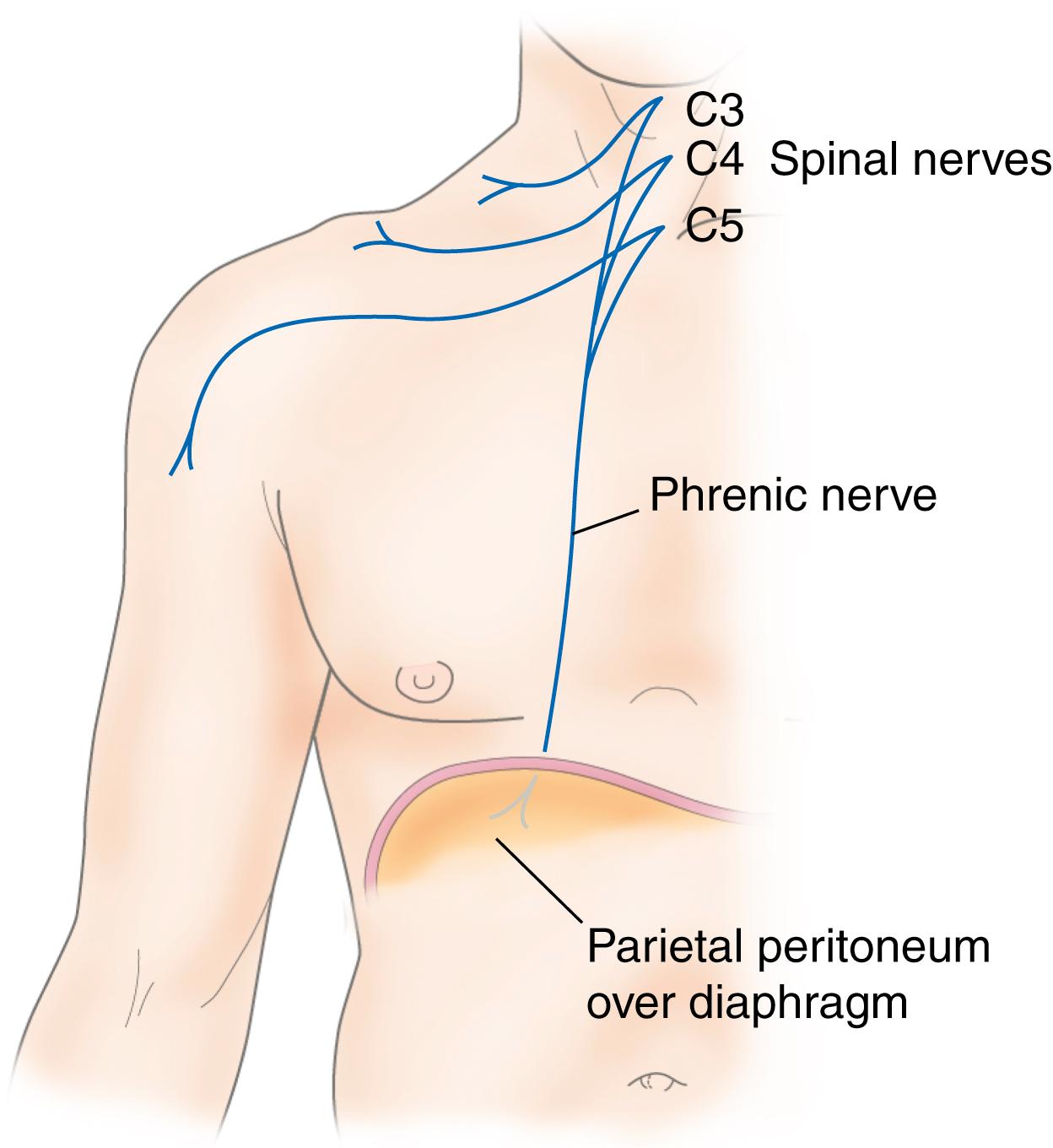
The visceral peritoneum forms a partial or complete investment of the intraabdominal viscera. It is derived from the splanchnopleural layer of the lateral plate mesoderm and shares its nerve supply with the viscera (i.e., the autonomic nerves). Visceral pain is mediated through the sympathetic branches of the autonomic nervous system, with afferent nerves joining the presacral and splanchnic nerves, which eventually join thoracic (T6–T12) and lumbar (L1–L2) segments of the spinal cord. The visceral peritoneum and the viscera are insensitive to mechanical, thermal or chemical stimulation and can therefore be painlessly handled, cut or cauterised. However, they are sensitive to tension, whether due to overdistension or traction on mesenteries, and to visceral muscle spasm and ischaemia.
Visceral pain is typically described as dull and deep-seated. Because it does not have somatic innervation, visceral pain is not localised but instead felt as referred pain located in the abdominal midline corresponding to the viscus during development, Therefore, pain derived from foregut structures (the lower oesophagus to the second part of the duodenum and its derivatives, e.g., biliary tree, pancreas) is felt in the epigastric area. Pain from midgut structures (the second part of the duodenum to the splenic flexure of the colon) is felt around the umbilicus, and pain from hindgut structures (the splenic flexure to the rectum) is felt in the hypogastrium/suprapubic area.
The division of abdominal pain into visceral and somatic pain is useful for diagnostic purposes, as some pathologic conditions will result in a mixed picture yet with a recognizable pattern. For example, acute appendicitis ‘classically’ presents with abdominal pain that is initially felt in the umbilical area (referred to as midgut pain) resulting from appendicular obstruction, which gradually localises to the right iliac fossa and becomes sharper in nature as the overlying parietal peritoneum becomes involved due to the inflammation/perforation of the appendix.
Visceral abdominal pain is mediated by the sympathetic nervous system and is typically deep-seated and poorly localised. It is felt in the upper, mid or lower abdominal midline depending on the embryologic origin of the affected part of the gut. This is known as ‘referred’ pain
‘Colic’ is a form of visceral pain that arises from a hollow viscus with muscle in its walls (e.g., gut, gallbladder and ureter) that results from excessive muscle contraction, often against an obstructing agent
Patients experiencing colic are usually unable to remain still during the bout of pain but are pain-free between attacks
Parietal pain, such as that caused by parietal peritonitis, is mediated by somatic nerves and is localised to the site of inflammation. It causes involuntary rigidity (‘guarding’) of the overlying muscles and is exacerbated by movement
Some areas of the peritoneum (e.g., the pelvis, posterior abdominal wall) are ‘nondemonstrative’ in that parietal peritonitis may be present without tenderness or guarding of overlying muscles
As seen from the list of surgical conditions presenting with acute abdominal pain ( Table 13.2 ), two main underlying pathologic processes are involved, inflammation and obstruction, which may be triggered by a variety of underlying abnormalities. A combination of abnormalities and processes may be involved in any one patient.
Acute inflammation of an intraabdominal organ or adjacent peritoneum may occur because of a variety of irritants, which may be broadly classified as infective or noninfective ( Table 13.4 ).
| Infective |
|
|
|
|
| Noninfective |
|
|
|
|
|
|
|
No matter the trigger of the inflammation, the subsequent pathologic process is the same. There is reactive hyperaemia of the injured tissue due to capillary and arteriolar dilatation; exudation of fluid into the tissues as a result of an increase in the permeability of the vascular endothelium; release of proinflammatory mediators; and an increase in filtration pressure. Finally, there is migration of leucocytes from the vessels into the inflamed tissues.
The clinical consequences of the inflammatory process depend on many factors, including the nature of the underlying condition, its severity and duration, the organ involved and the patient’s age and comorbidity. In general, the patient will complain of abdominal pain and tenderness, which occurs partly due to tissue stretching and distortion and partly due to the release of inflammatory mediators, some of which also mediate pain. On general assessment, the patient may be pyrexial and have a tachycardia. Examination of the abdomen will reveal tenderness in the affected area, with additional guarding, rebound and rigidity if the parietal peritoneum is involved. Investigations may reveal raised white cell count and C-reactive protein (CRP).
Inflammation of the peritoneum (peritonitis) may be classified according to extent (either localised or generalised) and aetiology ( Table 13.5 ). In a surgical setting, the most common cause of peritonitis is perforation of an intraabdominal viscus. Generalised peritonitis makes patients much sicker and causes higher mortality than localised peritonitis; hence the human body has developed innate immunity mechanisms to limit the progression of intraabdominal sepsis. Inflammation of the peritoneum results in an increase in its blood supply and local oedema formation; transudation of fluid into the peritoneal cavity; and accumulation of a protein-rich fibrinous exudate. In the normal state, the greater omentum constantly alters its position within the abdominal cavity because of intestinal peristalsis and abdominal muscle contraction. However, in the presence of inflammation, it will adhere to, and surround, the abnormal organ. The fibrinous exudate effectively glues the omentum and other adjacent structures (e.g., small bowel) to the inflamed viscus, walling it off and preventing further inflammatory spread. In addition, the exudate inhibits intestinal peristalsis, resulting in a paralytic ileus that limits the spread of inflammation and infection. As a result of the ileus, fluid accumulates within the lumen of the intestine, along with the formation of intraperitoneal transudate and exudate, which leads to a decrease in the intravascular volume, producing the clinical features of hypovolaemia.
| Generalised peritonitis |
| Primary: infection of the peritoneal fluid without intraabdominal disease |
|
|
|
|
| Secondary : inflammation of the peritoneum arising from an intraabdominal source |
|
|
|
|
|
|
|
|
| Localised peritonitis |
|
The clinical features of peritonitis vary considerably, but the most common symptom is abdominal pain, which is constant, sharp and almost always exacerbated by movement.
The terms peritonitis , peritonism or peritoneal irritation are all used to describe the collection of clinical signs associated with inflammation of the parietal peritoneum found on clinical examination, a key aspect of the acute abdomen assessment. Diagnosing peritonitis encompasses clues from the history (pain worse on coughing or sneezing; “I felt every bump in the ambulance”) and eliciting signs of peritoneal irritation such as tenderness, ‘guarding’, rigidity (involuntary) and rebound tenderness. Distinguishing generalised from localised peritonitis is a key clinical distinction; the latter may be treated nonoperatively in some cases, but the former almost always requires surgical intervention.
An infarct is an area of ischaemic necrosis caused by an occlusion of the arterial supply or venous drainage in a particular tissue, or by a generalised hypoperfusion in the context of shock ( Table 13.6 ). The typical histologic feature of infarction is ischaemic coagulative necrosis. An inflammatory response begins to develop along the margins of an infarct within a few hours, stimulated by the presence of the necrotic tissue.
| Occlusive |
| Arterial |
|
|
|
| Venous |
|
|
| Nonocclusive |
| Shock |
|
|
|
| Vasoconstrictor drugs |
The consequences of decreased perfusion of a tissue depend on several factors: the availability of an alternative vascular supply, the rate of development of the hypoperfusion, the vulnerability of the tissue to hypoxia and the blood oxygen content. In the context of acute abdominal pain, intestinal infarction is the most common cause. Other organs that may infarct include the ovaries, kidneys, testes, liver and spleen.
In general, the patient will complain of severe abdominal pain, and since ischaemia is precipitated by vascular occlusion, the onset is almost always sudden. Infarction and ischaemia are potent triggers of inflammation of the affected structure, and the clinical features reflect this.
Spontaneous perforation of an intraabdominal viscus may be the result of a range of pathologic processes. Locally advanced malignancy of the bowel, ulceration, inflammation, infection or ischaemia may weaken the bowel wall to cause perforation, for example, peptic ulceration or acute diverticulitis. Perforation may occur due to an increase in the intraluminal pressure of a viscus, such as occurs in a closed-loop bowel obstruction (e.g., obstructing colonic tumours with a competent ileocaecal valve) when the obstructed bowel cannot decompress itself proximally ( Fig. 13.2 ). Perforation can also be iatrogenic, perhaps by unsuspected bowel injury during a difficult operation or an endoscopic procedure.
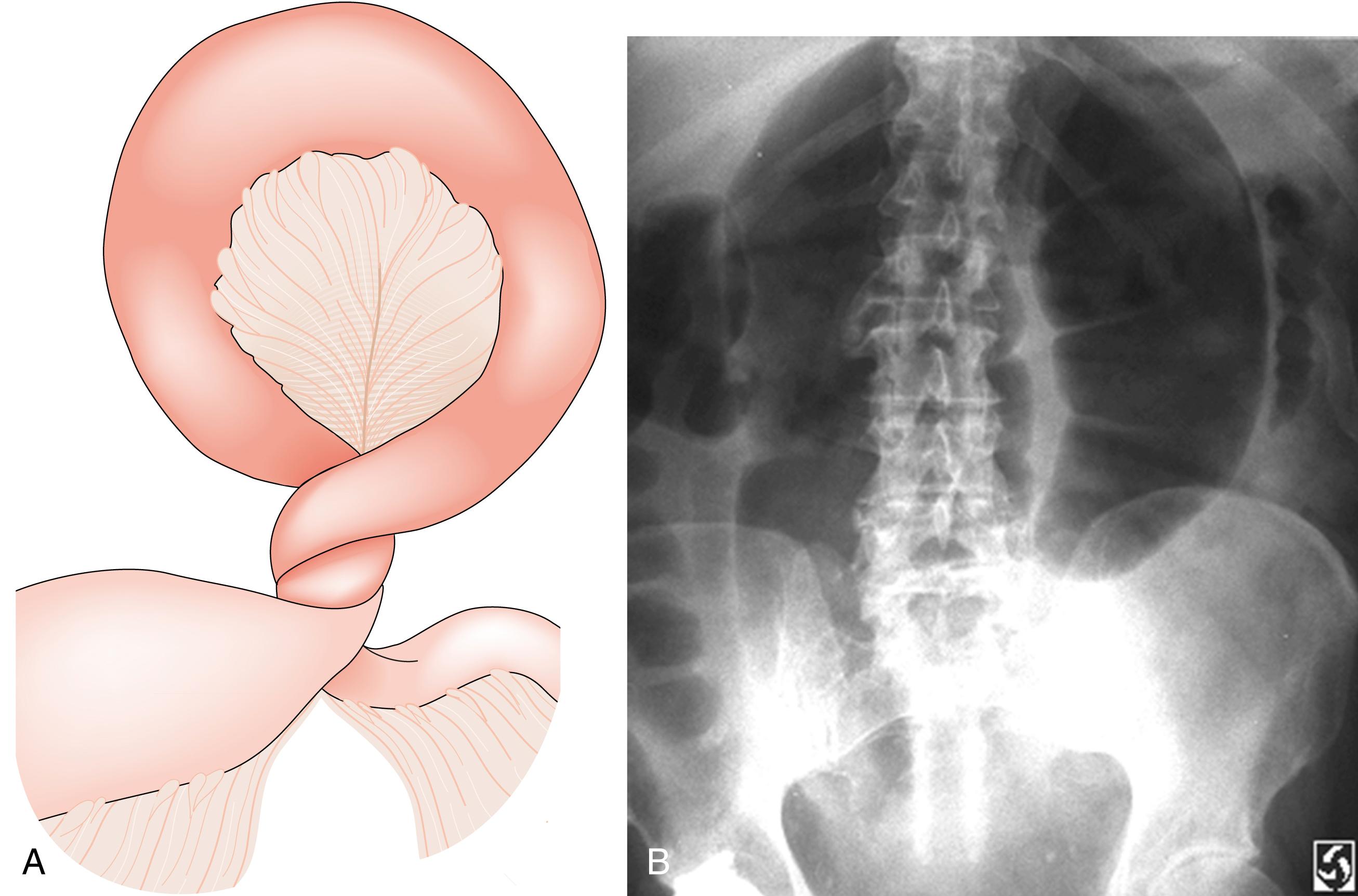
Spontaneous perforation of a viscus normally results in the sudden onset of severe and progressive abdominal pain, which initially will be localised to the affected area; depending on various factors, it may however rapidly progress to generalised peritonitis. The resultant clinical picture depends on the nature of the perforated viscus and the relative sterility and toxicity of the material within the abdominal cavity, in addition to the speed with which the perforation is surrounded and sealed (if at all) by the adjacent structures and omentum. The inevitable peritoneal contamination will lead to either localised or generalised peritonitis, and the associated symptoms and signs, as already discussed. Intestinal content, blood and bile are all irritants to the peritoneum.
The term obstruction refers to impairment of the normal flow of material through a hollow viscus. It may be caused by the presence of a lesion within the lumen of the viscus, an abnormality in its wall or a lesion outside the viscus causing extrinsic compression.
The smooth muscle in the wall of the obstructed viscus will contract to overcome the impedance. This reflex contraction produces a squeezing, knotting pain known as ‘colic’. Note that colic refers mainly to the character of the pain but is often misused as a term meaning pain that waxes and wanes. In fact, only intestinal colic does this; both biliary and ureteric colic can last for many hours before subsiding.
If the obstruction is not overcome, there will be an increase in intraluminal pressure and proximal dilatation. The result depends on the anatomic location of the obstruction, whether it is partial or complete, and whether the blood supply to the organ is compromised. For example, a ureteric calculus in a single functioning kidney can cause urinary outflow obstruction resulting in a dilatation of the proximal ureter and renal pelvis, consequent ‘postrenal’ acute renal failure and even calyceal rupture. An obstructed inguinal hernia, on the other hand, will not only produce proximal dilatation of the intestine within the hernia sac (causing colicky pain and vomiting) but may also result in ischaemia of the trapped bowel wall, leading to infarction and perforation.
The ability to make an accurate assessment by taking a good history and performing an appropriate examination is a vital skill in the management of the patient with acute abdominal pain. Although an exact diagnosis often requires further investigations, the formulation of an appropriate, safe and effective management plan is important. In most cases, it is possible to perform a full history and thorough examination, but this is not always so. Occasionally a rapid evaluation in concert with immediate resuscitation is required.
The main presenting complaint of patients with an acute abdomen is pain. The characteristics of the pain ( Table 13.7 ) give important clues to the likely underlying diagnosis, and these should be explored in depth.
|
|
|
|
|
|
|
|
|
The site of abdominal pain is perhaps the most valuable pointer to the underlying diagnosis. To describe the site of pain, the abdomen is traditionally divided into either quarters or nine regions ( Figs. 13.3 and 13.4 ).
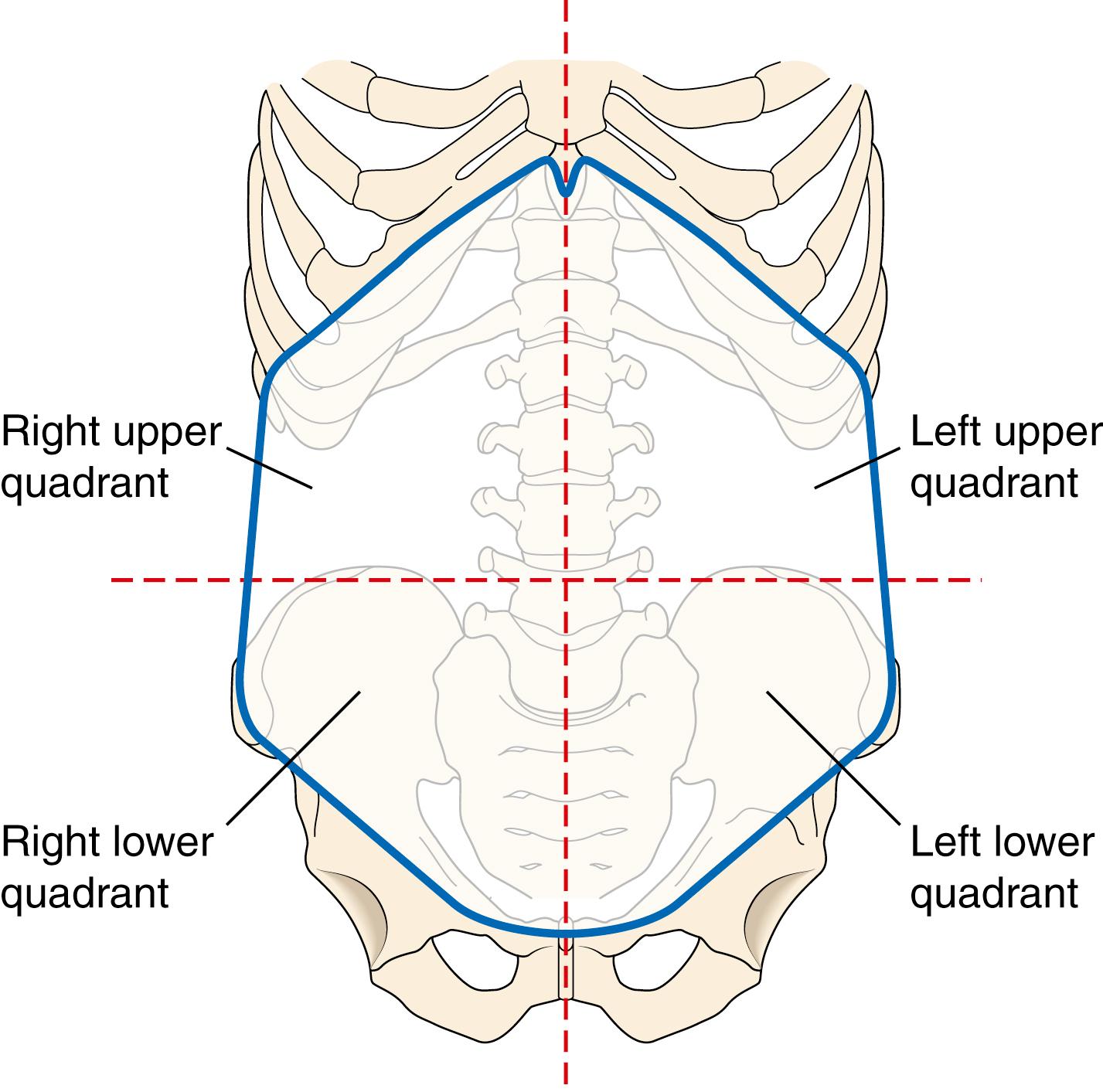
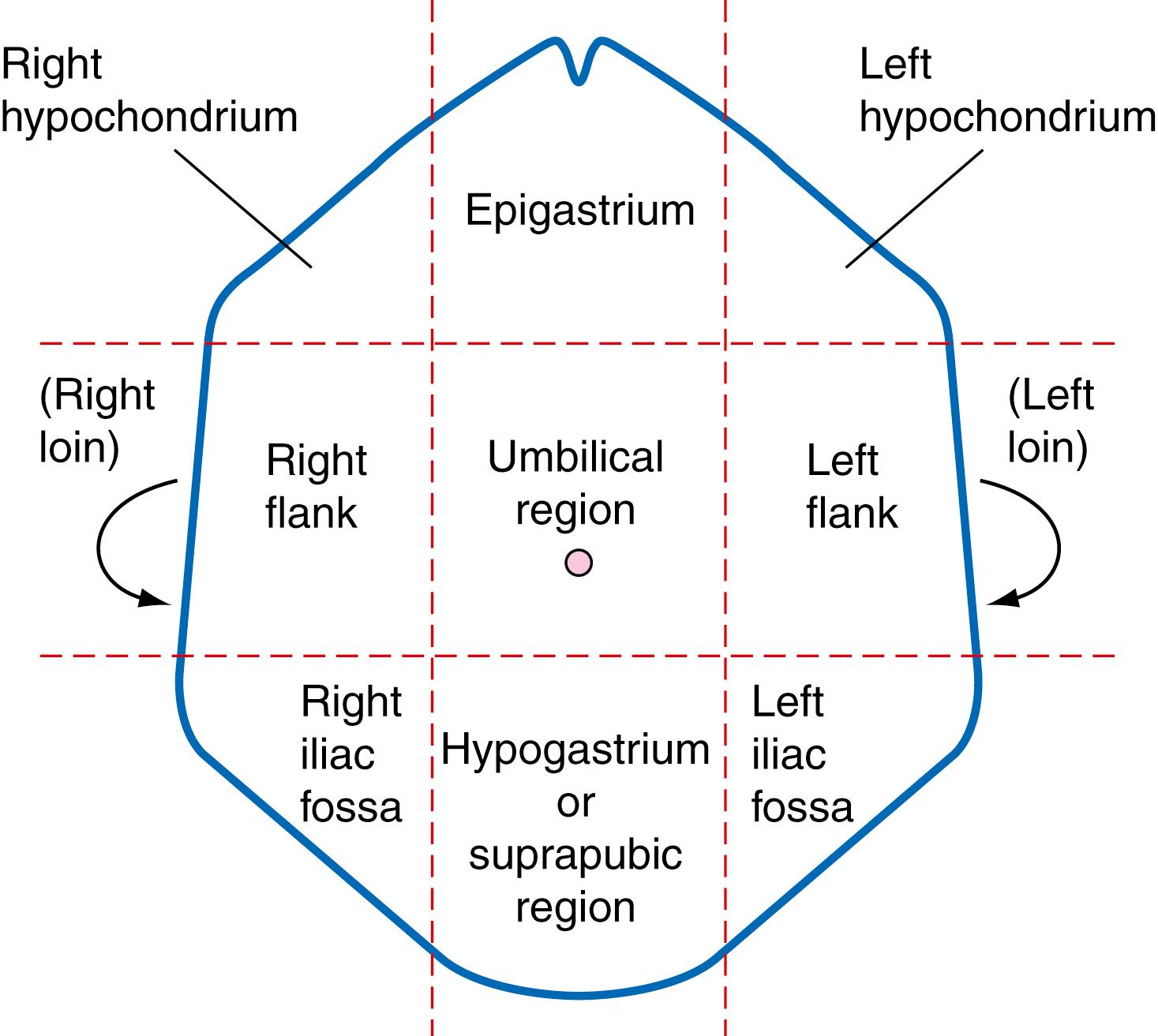
The various characteristics of abdominal pain, as shown in Fig. 13.5 , are essential in helping the clinician formulate a differential diagnosis.
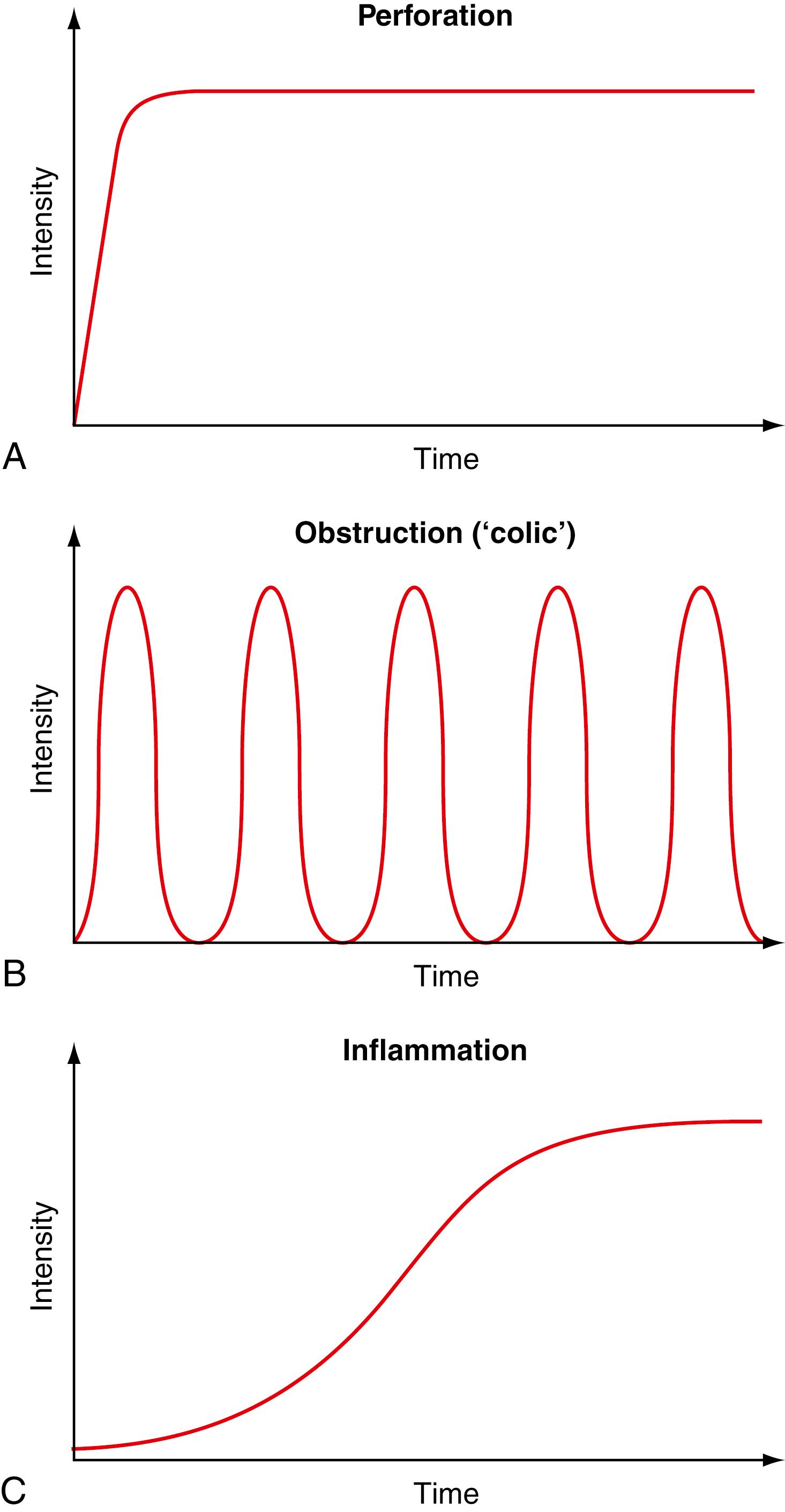
As discussed earlier, inflammation produces a constant pain, made worse by movement or coughing, which suggests inflammation of the parietal peritoneum. In this situation, the patient will often be seen to lie very still and take shallow breaths to avoid exacerbating the pain.
Obstruction of a muscular viscus produces a ‘colicky’ pain characterised by a squeezing quality; patients may describe it as gripping, knotting, a spasm, etc. The duration of pain depends on the viscus affected, but the patient is usually pain-free between spasms. The pain itself is very severe and may be improved by moving around or drawing the knees up towards the chest; the key distinction here is that, unlike peritonitis, it is not improved by lying motionless. Underlying inflammation must be suspected when a colicky pain does not disappear between spasms and becomes continuous. In the case of intestinal obstruction, this might mean strangulation and impending infarction, and urgent surgery is then required.
Radiation is the process whereby pain extends directly from one place to another, while usually remaining present at the site of onset. It is not the same as ‘referred’ pain, described earlier. When a pain radiates, it sometimes signifies other structures are becoming involved; in other cases, the reason for radiation is unknown. Characteristic patterns can be discerned: for example, pain from a duodenal ulcer may radiate through to the back, indicating that inflammation has occurred through the wall of the duodenum to involve retroperitoneal structures; ureteric pain radiates to the groin; and biliary colic radiates around the right subcostal margin.
The onset of pain can be sudden or gradual. Typically, pain from a perforation or infarction is sudden, whereas pain from inflammation is more gradual. Patients with the former can usually remember exactly what they were doing at the time of onset, whereas in the latter localisation in time is more difficult.
Pain is subjective. Every individual has a different reaction to pain, reflecting the patient’s personality as well as the underlying pathology. Severity can be estimated by assessing the effect of the pain on the patient’s life. How long after the start of the pain did they visit a doctor? Were they unable to attend work? Did the pain interfere with their sleep? In women, is it worse than childbirth?
Once a pain has occurred, it may remain the same, gradually improve or worsen, or fluctuate. Again, pattern recognition is important: pain that is recurrent but self-limiting over a period of months to years suggests certain possibilities, e.g., biliary colic or acute diverticulitis. Pain that is constant and progressive suggests more sinister pathology, e.g., malignancy. Even after admission to hospital, how pain alters over time during clinical observation is a key determinant of pathology, e.g., acute appendicitis, as discussed elsewhere in this chapter.
It is also useful to note whether the pain moves. Acute appendicitis is a classic example of this, starting as a vague periumbilical referred pain (visceral), moving to the right iliac fossa and becoming sharper as the adjacent parietal peritoneum becomes inflamed (somatic).
Patients should be questioned about other symptoms, particularly those in the gastrointestinal systemic inquiry. Profuse vomiting and absolute constipation suggest bowel obstruction; acute pancreatitis is often accompanied by severe nausea and vomiting, though not of a high volume of fluid; preceding weight loss should raise concern about malignancy, etc.
While taking a history, the clinician should form a general impression of the state of the patient. The septic patient with generalised peritonitis may look pale and sweaty, lie flat on the bed, be cerebrally obtunded and be unable to move without experiencing agony. Others, despite complaining of extremely severe pain, look surprisingly well, have a good colour, sit up in bed, talk normally and move freely. All these observations should be noted and recorded, along with the temperature, pulse, blood pressure and respiratory rate.
General examination should start with the vital signs on the observation chart: tachycardia, or worse, hypotension, indicate serious pathology in the context of the acute abdomen and should be acted on immediately. Other important features to look for on general examination include clinical evidence of anaemia, jaundice, cyanosis and dehydration. Be aware that physical signs are often less obvious than might be expected in the elderly, the obese and the generally unwell: frail patients may not have the abdominal musculature to display the ‘board-like’ guarding seen in young patients in response to a perforated peptic ulcer; medications such as beta-blockers and steroids can blunt physiologic responses. As in every emergency patient, a full examination, including the cardiovascular, respiratory and neurologic systems, in addition to the abdomen and pelvis, must be carried out and the results documented. Specific details relating to the abdominal examination are described in the following section and in Table 13.8 .
| Method | Question | Significance |
|---|---|---|
| Inspection | What is the abdominal contour? | Distension: intestinal obstruction or ascites |
| Does the abdomen move with respiration? | Rigid abdomen: peritonitis | |
| Can the patient blow out/suck in the abdomen? | Rigid abdomen: peritonitis | |
| Does the patient lie still or writhe about? | Fear of movement: peritonitis Writhes about: colic |
|
| Are there visible abnormalities? | Scars: relevant previous illness, adhesions Hernia: intestinal obstruction Visible peristalsis: intestinal obstruction Visible masses: relevant pathology |
|
| Gentle palpation | Is there tenderness, guarding or rigidity? | Tenderness/guarding: inflamed parietal peritoneum Rigidity: peritonitis |
| Deep palpation | Are there abnormal masses/palpable organs? | Palpable organs/masses: relevant pathology |
| Is there rebound tenderness? | Rebound tenderness: peritonitis | |
| Percussion | Is the percussion note abnormal? | Resonance: intestinal obstruction |
| Loss of liver dullness: gastrointestinal perforation | ||
| Dullness: free fluid, full bladder | ||
| Shifting dullness: free fluid | ||
| Auscultation | Are bowel sounds present/abnormal? | Absent sounds: paralytic ileus Hyperactive sounds: mechanical obstruction, gastroenteritis |
| Is there a bruit? | Bruit: vascular disease | |
| Do not forget to: | ||
| Examine the groin for hernias and lymphadenopathy | ||
| Consider a digital rectal examination | ||
| Consider a vaginal examination when appropriate | ||
| Examine the chest | ||
The patient must be adequately exposed and positioned to examine the abdomen. The full extent of the abdomen should be visible, meaning the patient should be exposed from ‘nipples to knees’. This prevents the common mistake of not examining the breasts, groin and external genitalia. Patient dignity should be maintained, and the breasts and genitalia should be covered once assessed. In some cultures, this may be difficult for a male doctor. The presence of a chaperone or first-degree female relative, tact, good communication skills and a professional attitude will all help to overcome this barrier. Patients should be positioned supine on the bed or trolley with a single pillow behind the head and shoulders with the arms resting by the side. This position maximizes the area between symphysis pubis and xiphisternum for inspection and palpation, and minimises the anteroposterior distance for palpating retroperitoneal structures.
Inspection of the abdomen may reveal a wealth of information. Abdominal swellings due to abnormal enlargement of the liver, kidneys or spleen, and tumours of the bowel, ovaries or other intraabdominal or retroperitoneal structures may be visible. Scars from previous abdominal or pelvic surgery may be observed and are of importance in the presence of small bowel obstruction, which may be secondary to postoperative adhesions. All scars should be tested for the presence of incisional hernias. Distended veins on the abdominal wall may be secondary to portal hypertension or occlusion of the inferior vena cava. The abdomen may be generally distended by intraabdominal blood or fluid, or due to intestinal obstruction. In cases of obstruction, intestinal peristalsis may be visible if the patient is thin.
Become a Clinical Tree membership for Full access and enjoy Unlimited articles
If you are a member. Log in here